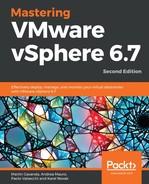There are different types of storage, with different protocols, architectures, scaling capabilities, and purposes. In a virtual environment, you will need a resilient and reliable storage solution that meets your required performance and that can scale for the future. This is only possible using enterprise storage products, with some exceptions for the ROBO and SMB scenarios, as discussed in Chapter 2, Designing and Planning a Virtualization Infrastructure.
Enterprise-class storage can be classified in different ways:
- Direct-Attached Storage (DAS)
- Network Attached Storage (NAS)
- Storage Area Network (SAN)
- Object-based storage/cloud storage
For VMware vSphere, the first three storage classes are the most relevant as they are the only solutions that can be used for running VMs. Object-based storage, however, could be used by other solutions (such as backup products), and maybe also by vSphere in the future. The main differences between these different types of storage are the types of services the provide, the different ways in which they can be used, their performance, and how they can scale.
Several storage solutions are based on the DAS storage type but provide shared storage for an ESXi server. Using SAS switching, you can connect multiple SAS HBA adapters to an SAS storage device, but compared to SAN or NAS solutions these storage arrays have limits regarding scaling, and hence are fine for smaller projects but not large-scale virtualization projects.
All enterprise storage can be classified according to its architecture. There are many different enterprise storage architectures. The two most commonly used solutions are as follows:
- Scale-in or scale-up: This is where the storage grows in capacity (and initially also in performance) by adding new disk shelves.
- Scale-out: This is where more arrays are managed as a single logical storage performance and the capacity can scale by adding new arrays.
From a performance perspective, storage arrays or storage types are commonly classified into the following tiers:
- Tier 0: Very high-performance storage, such as the All-Flash Array (AFA). Tier 0 storage is getting more and more popular as the prices of Enterprise-class SSDs are dropping. It provides unmatched I/O performance.
- Tier 1 or primary storage: This is usually the main storage and corresponds to the VMware side in different datastores.
- Tier 2 or secondary storage: This is storage not (usually) used from VMware production environments. It stores online archives, backups, cold data, and so on.
- Tier 3: This can be long-term and offline archival storage repositories, such as tapes, or copies of backups on public cloud storage.
